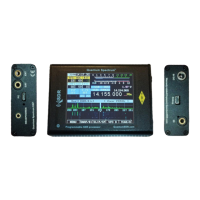Spectrum DSP M2 User Manual V1.1
• 7.2 kHz – This is suitable only for “Narrow” operation and even this will result in a bit of added
distortion as the filter about as narrow as it may be to pass audio. Using this setting the weak-
signal sensitivity is the highest amongst the FM filter bandwidth settings since this narrowest
filter also intercepts less noise under weak-signal conditions.
• 10 kHz – This is the “default” bandwidth and is suitable for “Narrow” bandwidth and while it will
work for “Wide” bandwidth, slight distortion may occur on voice peaks.
• 12 kHz – This is wider than necessary for “narrow” bandwidth and is recommended for “Wide”
bandwidth.
Subaudible tone generation:
The menu item “FM Sub Tone Gen” enables and sets the frequency for subaudible tone generation.
All common frequencies (including NATO and others) are included and when set to something other
than OFF, the tone is modulated on the carrier during transmit.
The tone deviation in “Narrow” mode is approximately +/- 300 Hz and around +/- 600 Hz in “Wide”
mode.
Subaudible tone detection:
Also known as “Tone Squelch” this is enabled by setting the menu item “FM Sub Tone Det” to
something other than “Off”. When it is activated, it is required that BOTH the squelch be open AND
the tone be detected.
Comment:
Sub-audible tone detection, particularly in the presence of noise, is rather difficult. If the tone
detection drops in and out on weak signals you may wish to turn it off.
Tone Burst generation:
Although it is getting rarer, some repeaters may still require “tone burst” and this is enabled by setting
the menu item “FM Tone Burst” to something other than “Off”. Two tone frequencies are currently
provided: 1750 Hz and 2135 Hz. The duration of the tone is 1 second.
To transmit a tone burst:
• Key the transmitter. (It must be in FM mode)
• While the transmitter is keyed Press-and-Hold the Mode button (set-up dependent).
• While a tone burst is being generated the “FM” on the mode indicator changes to a yellow
background.
Squelch/Tone decode indications:
The “FM” mode indicator changes according to the squelch and tone detection status:
• “FM” on dark blue background – Squelch closed (and tone decoder not decoding).
• “FM” on light background – Squelch open.
◦ If tone decoding is not active, audio will be heard.
◦ If tone decode is active, audio will not be heard, but this indicates that a signal is present
(or the squelch is loose) but does not match the tone decode setting.
• “FM” on red background – This is displayed if the tone decoder is detecting a tone: Audio will
be heard.
P 58

